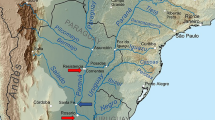Abstract
Chemical and physical water quality parameters havebeen analyzed in a synoptic study of 101 lakes and103 rivers and streams in Høylandet, a coastalcatchment in Central Norway. The area is sparselypopulated and most sites were unaffected by localpollution. Cambro-Silurian sedimentary rocks,porphyric granites and migmatitic gneisses arerepresented within the area and gave variableconcentrations of dissolved salts in surface water.Conductivity varied from 0.6 to 20 mS m-1 and pHfrom 5.0 to 7.6. Salt from sea spray dominated indilute water in more elevated parts of the catchmentwhile chemical weathering products were dominant inlower. The concentrations of all major ions and pHdecreased with increasing elevation. Non marinesulfate occurred in moderate concentrations. pHvalues less than 5.5 were rare and the area as a wholedid not seem to be subject to acidification.
Access this article
We’re sorry, something doesn't seem to be working properly.
Please try refreshing the page. If that doesn't work, please contact support so we can address the problem.
Similar content being viewed by others
References
Birkeland, T., 1958. Geological and Petrological Investigations in Northern Trøndelag, Western Norway. Nor. Geol. Tidsskr. 38: 328–420.
Blakar, I. A., I. Digernes & H. M. Seip, 1990. Precipitation and streamwater chemistry at an alpine catchment in central Norway. In Mason, B. J. (ed.), The surface waters acidification programme, Cambridge University Press, 69–73.
Dahl, E., 1996. The Høylandet Project–Introduction, Hydrobiologia 348: 1–3.
Dougan, W. K. & A. L. Wilson, 1974. The absorptiometric determination of aluminium in water. A comparison of some chromogenic reagents and the development of an improved method. Analyst 99: 413–430.
Driscoll, C. T., 1980. Chemical characterization of some dilute acidified lakes and streams in the Adirondack Region of New York State. Ph. D. Thesis. Cornell Univ.
Driscoll, C. T., R. D. Fuller & W. D. Schecher, 1989. The role of organic acids in the acidification of surface waers in the eastern U.S. Wat. Air Soil Pollut. 43: 21–40.
Eilers, J.M., D. F. Brakke & A. Henriksen, 1992. The inapplicability of the Gibbs model of world water chemistry for dilute lakes. Limnol. Oceanogr. 37: 1335–1337.
Gibbs, R. J., 1970. Mechanisms controlling world water chemistry. Science 170: 1088–1090.
Golterman, H. L., R. S. Clymo & M. A. M. Ohnstad, 1978. Methods for physical and chemical analysis of freshwaters. IBP Handbook No 8 (2nd edn). Blackwell 213 s.
Henriksen, A., 1979. A simple approach for identifying and measuring acidification of freshwater. Nature 278: 542–545.
Henriksen, A., 1982. Alkalinity and acid pricipitation research. Vatten 38: 83–85.
Henriksen, A., L. Lien, T. S. Traaen, I. S. Sevaldrud & D. F. Brakke, 1988. Lake acidification in Norway–Present and predicted chemical status. Ambio 17: 259–266.
Hesthagen, T., H. M. Berger, B. M. Larsen & R. Saksgård, 1995. Monitoring fish stocks in relation to acidification in Norwegian watersheds. Wat. Air Soil Pollut. 85: 641–646.
Hongve, D., 1993. Total and reactive aluminium concentrations in non-turbid Norwegian surface waters. Verh. int. Ver. Limnol. 25: 133–136.
Hongve, D. & G. Åkesson, in press. Spectrophotometric determination of water colour in Hazen units. Wat. Res. 30: 2771–2775.
Johnson, N. M., C. T. Driscoll, J. S. Eaton, G. E. Likens & W. H. McDowell, 1981. ‘Acid rain’, dissolved aluminium and weathering at the Hubbard Brook experimental Forest, New Hampshire. Geochim. Cosmochim. Acta 45: 1421–1437.
Mackereth, F. J. H., 1963. Some methods of water analysis for limnologists. Sci. Pub. Freshwat. Biol. Ass. 21: 71 s.
Muniz, I. P., 1991. Freshwater acidification: its effects on species and communities of freshwater microbes, plants and animals. Pros. r. Soc. Edinburgh 97B: 227–254.
NILU, 1990. Monitoring programmes for the Norwegian State Pollution Control Authority. Description of monitoring stations May 1990. Report 416/90. Norwegian Institute forAir Research (NILU), Lillestrøm.
Norton, S. A. & A. Henriksen, 1983. The importance of CO2 in evaluation of effects of acidic deposition. Vatten 39: 346–354.
NVE, 1987. Runoff map of Norway (1930–60), 1:500 000, Sheet 5. Norwegian Water Resources and Energy Administration (NVE), The Directorate of Water Resources, Hydrology Department.
Otnes, J. & E. Roestad, 1978. Hydrologi i praksis. Ingeniørforlaget. 314 s.
Reuss, J. O. & D. W. Johnson, 1986. Acid deposition and the acidification of soils and waters, Springer, New York, 1986.
Seip, H. M., I. A. Blakar, N. Christophersen, H. Grip & R. Vogt, 1990. Hydrochemical studies in Scandinavian catchments. In Mason, B. J. (ed.), The Surface Waters Acidification Programme. Cambridge University Press, 19–29.
Skjelkvåle, B. L. & A. Henriksen, 1995. Acidification in Norway–status and trends. II. Surface-and groundwater. Wat. Air Soil Pollut., 85: 629–634.
Sollid, J. L. & L. Sørbel, 1983. Nord-Trøndelag Fylke. Quarternary geological map 1:250000. Geographic Institute, University of Oslo.
Solorzano, L., 1969. Determination of ammonia in natural waters by the phenolhypochlorite method. Limnol. Oceanogr. 14: 799–801.
SFT, 1988. Annual report. 333/88. The Norwegian State Pollution Control Authority (SFT), Oslo.
Stainton, M. P., 1974. An automated method for determination of chloride and sulphate in freshwater using cation exchange and measurement of electrical conductance. Limnol. Oceanogr. 19: 707–711.
Stumm, W. & J. J. Morgan, 1981. Aquatic chemistry. John Wiley & Sons, New York.
Sverdrup, H. U., M.W. Johnson & R. H. Fleming, 1942. The oceans. Prentice-Hall, New York.
Author information
Authors and Affiliations
Rights and permissions
About this article
Cite this article
Blakar, I.A., Hongve, D. On the chemical water quality in Høylandet, a reference area for acidification research. Hydrobiologia 348, 39–47 (1997). https://doi.org/10.1023/A:1003081015724
Issue Date:
DOI: https://doi.org/10.1023/A:1003081015724




